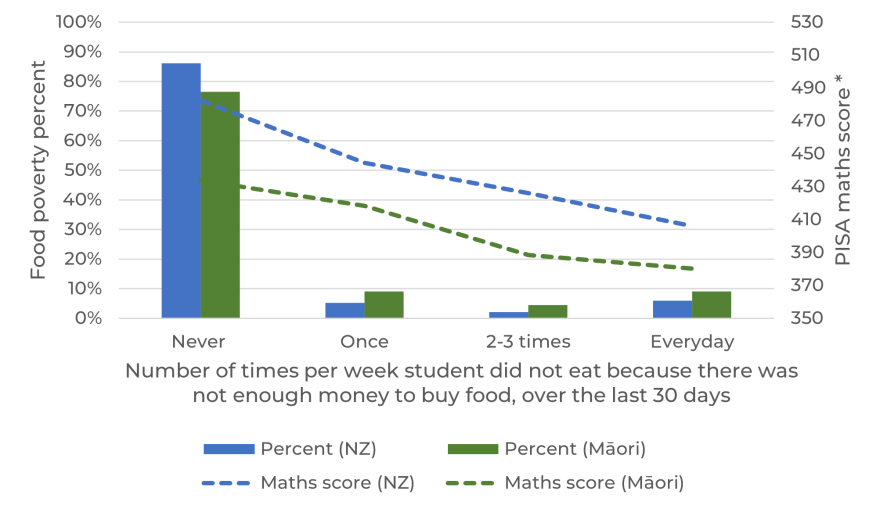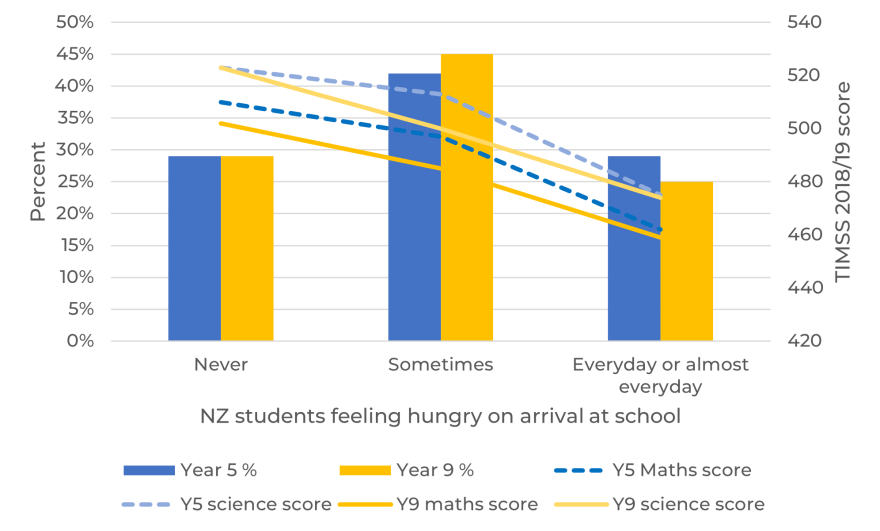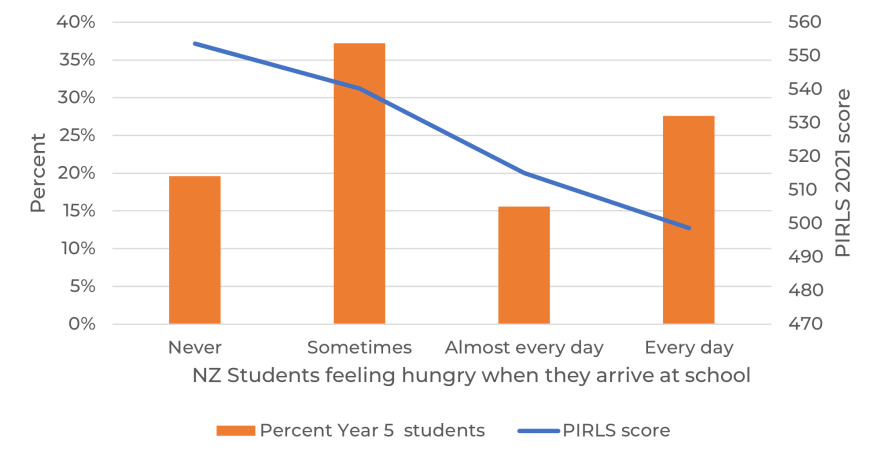Summary
Associate Minister of Education, David Seymour wants to cut funding to the Ka Ora, Ka Ako Healthy School Lunch Programme by 30-50%, claiming it does not improve attendance or school achievement.
In part two of a three-part series, we highlight that the programme evaluations commissioned by the Government have never sought to evaluate impact on school achievement. In the absence of direct impact evaluation, we present findings from three large-scale international studies, describing the compelling relationship between hunger in schools in Aotearoa New Zealand and achievement, linking this back to the need for food poverty interventions like Ka Ora, Ka Ako. This is particularly important for ākonga Māori, who make up half of the students receiving the lunches, and for whom, lower on average achievement is exacerbated by higher rates of food poverty.
Earlier this month the coalition Government announced that the Ka Ora, Ka Ako school lunch programme was under review, with Associate Minister of Education David Seymour announcing that funding may be cut by 30-50% in this year’s budget. The main reasons given for this cut were that evaluations of the programme had not shown any impact on attendance and achievement.
The Nourishing Hawke’s Bay: He wairua tō te kai team has been researching the impact of the school lunches programme since 2020 when it was first introduced in a few pilot schools in three regions. We have reported high rates of students running out of food at home in schools eligible for the programme.1 We have held focus groups with whānau and high school students to document how the programme reduces financial hardship and discussed ways to increase uptake and reduce food waste and food surplus.2 We have interviewed school lunch suppliers reporting the integral role of school staff in programme success3, delved into whether it can be successfully implemented in schools implementing Te Ao Māori approaches,4 documented the broad impacts at the child, whānau, school, community and food systems levels,5 and further demonstrated how a well-implemented programme can enhance policy outcomes across a range of sectors.6
We have also followed closely the Ministry of Education’s interim analysis7, a larger evaluation on attendance, hunger and wellbeing8,9 and the kaupapa Māori evaluation of the iwi and hapu model.10 In all of this time, we have not seen any evaluation by the Ministry of Education on the impact of the lunches on student achievement.
One of the reasons this evaluation would be very hard to do is because of the confounding factors. By definition, schools that receive the lunches are lower advantage than schools that don’t and accordingly, student achievement in these schools is generally lower.
In the absence of evaluation data directly linking Ka Ora, Ka Ako participation to student achievement, we sought other indicators of the impact of hunger for students in New Zealand on school achievement and found that significant amounts of data exist.
Earlier this month we revealed data from the Programme for International Student Assessment (PISA) showing that students in Aotearoa New Zealand who go hungry due to lack of money, even just once a week, were two to four years behind in their achievement scores compared to students who never go hungry.11
Further analysis of the PISA 2022 results shows that for Māori students, the impact is even more severe with 23.5 % missing meals at least once a week (compared to 14% of students overall), and 9.5% missing meals every day compared to 6.5% overall. Overall, ākonga Māori have, on average, lower achievement in the PISA study compared to NZ as a whole. Ākonga Māori who go hungry are one to three years behind their peers who never go hungry (Figure 1, regression in Appendix). Lower than average PISA achievement for ākonga Māori is well documented,12 but these analyses highlight how low achievement is reduced even further by hunger. This is essential to consider in the context of Ka Ora, Ka Ako, where 50% of students are Māori.
Figure 1. Proportions of 15-year-olds students in food poverty (overall and for Māori) and associated PISA maths achievement from regression model after socioeconomic advantage held constant. *Category “4-5 times per week” has been removed in this graph due to lack of numbers in this category.
Two further international studies also provide powerful evidence on the impact of hunger on achievement for NZ students.
The Trends in International Mathematics and Science Study (TIMSS) looks at maths and science achievement for Year 5 and Year 9 students every four years across 58 countries.13 In Aotearoa New Zealand, over two thirds of Year 5 and Year 9 students feel hungry at least sometimes when they arrive at school (Figure 2). The gap between the scores for students arriving at school hungry every day or almost every day and those who didn’t feel hungry, was between 43 and 49 score points in maths and science. This was one of the highest gaps in achievement observed internationally. An update to this data with the results for TIMSS 2023 is expected this year.
Figure 2. Percentages of Year 5 and Year 9 students arriving at school hungry in Aotearoa New Zealand and maths and science achievement (TIMSS 2018/19)
The Progress in International Reading Literacy (PIRLS)14 study measuring Year 5 reading literacy every five years in 58 countries, provides a similar image of declining achievement over categories of increasing hunger; this time in reading. In NZ in 2021, over 80% of students, who have not yet finished primary school, reported feeling hungry on arrival at school and achievement dropped over 55 points for students who feel hungry every day (Figure 3).
Figure 3. Percentages of Year 5 students in Aotearoa New Zealand arriving at school hungry and reading achievement (PIRLS 2021)
The data tell a compelling story. These international large-scale assessments offer a valuable avenue for more in-depth and reliable exploration of the relationship between hunger and direct and comparable measures of achievement across countries.
In preparation for Budget 2024, these are the best available data showing how achievement drops off as student experience of hunger increases, across multiple subject areas and year groups, and reported by several studies. These studies show hunger poses a significant threat to educational achievement and requires immediate action.
Undoubtedly, the school lunch programme needs continuous improvement to ensure the food is high quality and appetising for students. However, the evidence is clear: Ka Ora, Ka Ako alleviates hunger8 and less hunger improves school achievement.
What’s new in this briefing?
- We report high rates of food poverty for 15-year-old Māori students in the PISA study.
- PISA, TIMSS and PIRLS now provide compelling evidence for the sizeable impact of hunger on student achievement across different age groups, study years and subject areas.
Implications for public health
- Hunger is a major threat to public health and educational attainment and needs to be urgently addressed.
- Hunger and corresponding drops in educational achievement are an equity issue and funding for lunches that address this should not be removed.
Authors details
Dr Pippa McKelvie Sebileau
Dr Renee Railton, Te Kura i Awarua, Eastern Institute of Technology, Napier
Competing interests: Authors declare no competing interests. The first author is a founding member of the Nourishing Hawke’s Bay research programme and was previously employed as a data analyst on the Programme for International Student Assessment study at the Australian Council for Educational Research.
Read part one of the series – Evidence for free school lunches: The bigger picture benefits
Acknowledgements: We are grateful to the Educational Measurement and Assessment team within the Ministry of Education for their analysis of the PISA data.
Appendices
Regression analysis for ākonga Māori - adjusting for socioeconomic deprivation
A linear regression model was used to estimate the effect that food insecurity (once a week, 2-3 times a week, 4-5 times a week and every or almost every day, reference: never) had on Māori students’ mean PISA maths score, holding the student’s level of socioeconomic deprivation constant (PISA ESCS variable).
SAS macro used – detailed here https://www.oecd.org/pisa/pisaproducts/pisadataanalysismanualspssandsassecondedition.htm
| Variable | Effect size Estimate | Standard error | t value |
| Intercept | 434.75 | 4.13 | 105.15 |
| Socioeconomic deprivation - ESCS | 27.07 | 3.27 | 8.29 |
| Food insecurity once a week | -15.70 | 10.49 | -1.50 |
| Food insecurity 2-3 times a week | -45.38 | 16.03 | -2.83 |
| Food insecurity 4-5 times a week* | -57.35 | 25.85 | -2.22 |
| Food insecurity every or almost every day | -53.73 | 9.89 | -5.43 |
*Note limited number of students in this category



